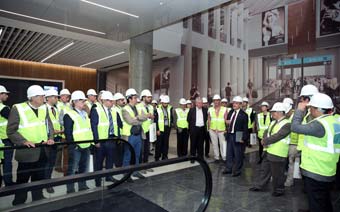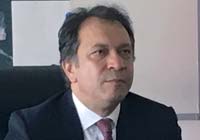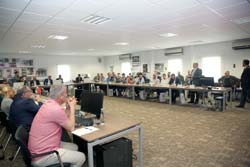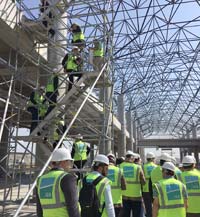News
ICI Member Industrialists at World’s Biggest Airport to Support Local Production
- 23.05.2016
- News

As part of the efforts to increase the contribution of local industrial enterprises to megaprojects in Türkiye, the Istanbul Chamber of Industry (ICI) paid a visit to the Third Airport construction site with member industrialists. Fifty-nine industrialists attended the meeting held at Odakule on January 7, 2016. The event was the continuation of the meeting held with IGA –contractor of the Third Airport’s construction.
Located in Arnavutköy the Third Airport of Istanbul still holds the title of the world’s biggest airport. The ICI Member industrialists who visited the construction site viewed a detailed presentation by the CEO Consultant Irfan Gündüz on the production ecosystem. In addition, Yusuf Akçayoğlu, IGA CEO, gave updates to the press members who accompanied the group.
Gündüz made statements about the phases and progress of the project. The attending industrialists then proceeded to the construction site where they received further information. Irfan Gündüz and Mustafa Ceylan, Procurement and Logistics Director, answered questions from attendees who enjoyed the opportunity to get a closer view of the Third Airport of Istanbul, the world’s biggest airport construction project.

Yusuf Akçayoğlu, CEO of IGA
Airports Joint Venture
As part of the visit, Yusuf Akçayoğlu, CEO of IGA Airports Joint Venture, provided information to industrialists and press members: “We will have completed the construction of the airport by 2018. The construction project has already created 15,000 jobs, and will create an additional 15,000 when the airport enters into service at fully capacity. The car park will have a capacity of 25,000 cars. The 95 meter-high ATC alone will cover an area of around 5,000 m2. All aspects of the airport feature the latest trends. It will be a spacious building with separate entrances for each airline company. We will thus direct the passengers to relevant locations in order to eliminate the risk of missing a flight. There will be six runways on a 76 million-m2 area, and we will serve 200 million passengers per year with flights to 350 destinations.”

CEO Yusuf Akçayoğlu stressed their complete reliance on local brands for the interior design. According to Akçayoğlu, stone samples were collected from all corners of Türkiye, and the company was willing to push its limits to procure all supplies –despite their rarity– from local brands.
Akçayoğlu further announced that all wooden components, counters, steel construction and glassware would be procured from local producers and continued: “We covered good ground after the ICI meeting and held many meetings with smaller groups. They were able to see their role in the project. We pressed foreign enterprises to cooperate with Turkish companies. In this sense, Turkish companies greatly benefited from us in terms of design, in particular. We made remarkable contributions to Turkish companies in both aviation and architectural design. What really matters is that we have been able to proceed thus far relying solely on local production, despite all opposing voices. This is a source of great pride for us. It had been initially seen as an impossible project in terms of design and construction.”

Akçayoğlu told that it was difficult to utilize local products in the project but they had decided to work with the local industry, despite the apparent challenges linked to granite procurement. He explained that China or India usually stepped in for such megaprojects and continued: “We always acted in an awareness that we should contribute to the Turkish industry and workforce as we have considered the project a national one. We have already completed the 24% of the project.”
After presentations and briefings, the industrialists examined an exact model of a finished passenger terminal alongside press members. They also observed the vast construction site at an elevated point and had their photograph taken with IGA executives.